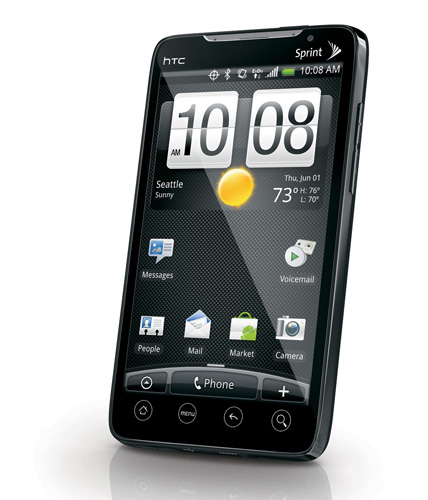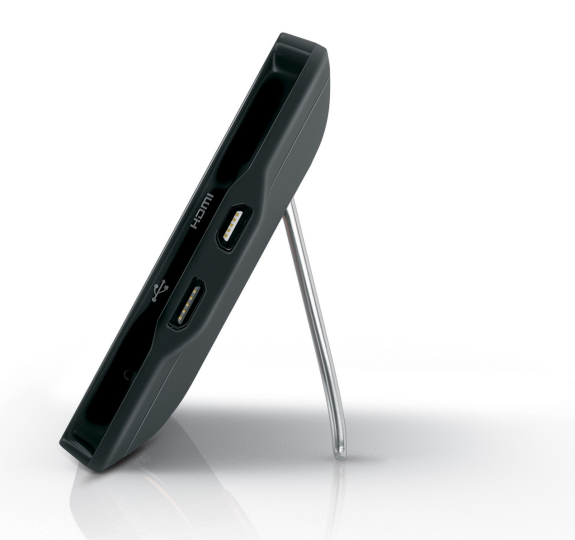HTC introduced the first (and till 2010 CTIA, the only) smartphone with WiMAX support (HTC MAX 4G) in Russia in 2009. So, it came as no surprise that Sprint chose HTC as its partner to bring out the first US WiMAX device in a smartphone form factor. Based on the tried and true Snapdragon platform (which also happens to be the brains behind the Google Nexus One), it is not the application processor which takes the laurels here, but the radio chipset used. Since the application processor also plays an important role in the end user experience, let us take a short detour to analyze the pros and cons of the Snapdragon platform used here before looking into the winner in the radio chipset.

The Snapdragon CPU used in the HTC EVO 4G is the QSD8650 along with 512MB RAM and 1GB of onboard storage. The QSD8650 has a Scorpion core at its heart, which is a specific implementation of the ARMv7 architecture. With an architecture license from ARM, Qualcomm spent almost 4 years and more than $300 million in designing it. Fabricated at TSMC in the 65nm process, the custom implementation can be clocked upto 1GHz. The performance of this single core ARMv7 implementation lies between that of ARM's own Cortex-A8 and Cortex-A9 designs. However, the CPU core in an app processor is only part of the story. The majority of the capabilities of the app processor lie in the surrounding IP, namely, the components responsible for the graphics, DSP and media processing, as well as the SoC infrastructure.
It is in this IP that Qualcomm may be said to be lacking. In the QSD8650, the GPU core is the Adreno 200. Qualcomm acquired AMD's handheld graphics unit for $65 million in 2006 and inherited the Imageon product line. This was later rechristened as Adreno, and to this date, Qualcomm uses graphics cores from this product line for their app processors. Unfortunately, the raw performance numbers for this product line don't compare well with the same generation product from other vendors such as Imagination Tech and Vivante, which are used by TI and Marvell respectively. The DSP and media processing in the QSD8650 is nothing to write home about either. With support for only upto 720p HD video encode / decode, it faces stiff competition from other app processors (which boast of 1080p encode / decode) being introduced into the market this year. It will be interesting to see how Qualcomm improves the Snapdragon platform in the dual core avatar slated for introduction later this year. We will cover the Snapdragon platform in more detail in a later article.
The real winner in the HTC EVO 4G is a relatively unknown semiconductor company, Beceem Communication. A provider of chips for 4G communication, the company exclusively powers the Sprint WiMAX network. It is believed in industry circles that the HTC EVO 4G's WiMAX support is powered by the Beceem BCSM250 (which is already a part of some of the other 4G equipment supplied for utilizing Sprint's network). Beceem, along with Motorola, also announced plans to support both WiMAX and LTE standards in the BCS500 introduced at the 2010 Mobile World Congress. All in all, Beceem looks set to be a dominant force in the US radio chipset market for 4G devices in the near future.
Update: It looks like the WiMAX baseband chip in the HTC EVO 4G isn't made by Beceem but rather Sequans Communication.












23 Comments
View All Comments
Strings - Wednesday, March 31, 2010 - link
How does the smart phone of today compare with the PC of yesterday? Would be interesting to see an article on the subject.ganeshts - Wednesday, March 31, 2010 - link
Thanks for your suggestion.We do have an article coming up on the different app processors in the market (as noted in the above article), and could probably add in information relevant to your request.
Personally, I would say that the smartphone of today is much more powerful than, say, a PC from 10 years back, and I dare say, probably more efficient at some common tasks than even the current day PCs (in terms of performance to power ratio). For example, most PCs from 2006 can't play back HD video without dropping frames (and the GPUs of those days didn't have decode acceleration either). However, even a small smartphone / PMP is able to playback such material flawlessly.
On the general purpose computing side, the advancement in smartphone capabilities has been entirely reliant on how much ARM has been able to innovate, coupled with advances in semiconductor manufacturing processes that the fabless semiconductor companies have access to. Usually, PC CPU vendors have an advantage with respect to the latter point.
The smartphone market has shaped itself in such a way that the most common tasks are taken care of through specialized hardware accelerators (for example, UI through 3d graphics cores, and media playback through specialized decode engines) which give it an advantage over PCs.
Whether PCs can be completely replaced by smartphones is something up for discussion. Again, my personal opinion is that it depends on the extent of success of cloud computing and how much people trust it. But then, that is a whole different domain altogether :)
Drizzt321 - Wednesday, March 31, 2010 - link
Because if it is, I'm of two minds about if I'd like this phone or not. See the ArsTechnica article (http://arstechnica.com/gadgets/news/2010/03/secret... which details some interesting things about it.ganeshts - Thursday, April 1, 2010 - link
Recently, it was brought to our attention that the WiMax baseband chip on the HTC EVO 4G is not manufactured by Beceem as previously thought, but by the French company Sequans Communication:http://www.eetimes.com/rss/showArticle.jhtml?artic...
We will continue to keep in touch with the market and bring you further information.
The error is deeply regretted.
ulbdd@free.fr - Saturday, April 3, 2010 - link
Indeed. The first WiMAX phone made by HTC for Russian operator Yota already did use a Sequans chipset, the SQN1130. The EVO uses the more recent SQN1210 with improved performance and lower power consumption and smaller footprint.See for example on Yota phone using SQN1130:
http://www.wimax.com/commentary/blog/blog-2009/nov...
And a more recent indicating Sequans again for EVO:
http://connectedplanetonline.com/ctia/2010/news/sp...
http://www.wirelessweek.com/News/Feeds/2010/03/wir...
For info on the SQN1210:
http://www.sequans.com/products-solutions/mobile-w...
dadicool - Friday, April 2, 2010 - link
Somehow Nvidia's Tegra2 doesn't make it to the list of App Processors. Omission or is it deliberate?ganeshts - Friday, April 2, 2010 - link
I believe Tegra2 is a very promising platform, but the truth is that it hasn't been demonstrated yet in a smartphone form factor. All we have seen at CES and MWC this year have been tablets and the like. It is likely that Nvidia is unable to fit the platform within the power envelop required by a smartphone.Personally, I think Tegra2 deserves kudos for being the first chip to bring out Cortex-A9 in silicon inside real third party demo-ed products (such as the Notion Ink Adam). Whether they are able to get it into production before OMAP4 (which is also Cortex-A9) products hit the market remains to be seen.
Randomblame - Friday, April 2, 2010 - link
I NEEeed a new phone msm7201a and 128mb of ram is just pathetic, I want the hd2 but at&t won't be carrying it and it won't support 3g on their network, desire looks nice but it won't be out for a while yet and it's android native which means there won't be the fun of porting linux to it or the freedom to run winmo when I want. I may have to get a topaz or rhodium to tide me over till the next great thingyouli - Friday, April 2, 2010 - link
input this URL:(http://www.madeshopping.net)
you can find many cheap and fashion stuff
(jor dan s-h-o-e-s)
(NBA NFL NHL MLB j-e-r-s-e-y)
( lv h-a-n-d-b-a-g)
(cha nel w-a-l-l-e-t)
(D&G s-u-n-g-l-a-s-s-e-s)
(ed har dy j-a-c-k-e-t)
(UG G b-o-o-t)
and so on nice items,welcome paste my link check it.
WE ACCEPT PYAPAL PAYMENT
YOU MUST NOT MISS IT!!!
Eurobrsg - Saturday, April 3, 2010 - link
It looks like Apple has recently purchased Intrinisity. Shortly after this article went live, I tried to visit their website, now I know what happened. Great article.